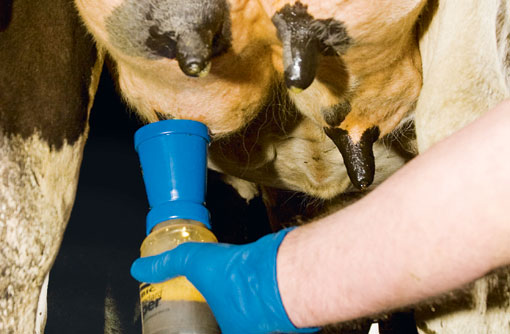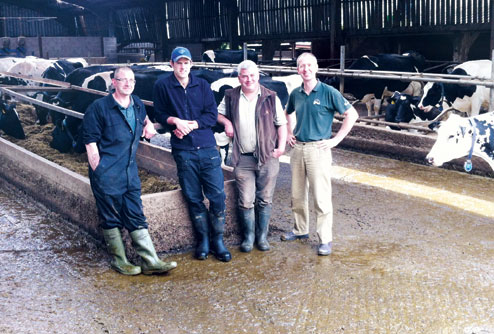Cut cull rates with better mastitis management

When cell counts at Church Farm, Kilmington, Warminster, began heading towards 300,000 cells/ml, and bactoscan levels started to read up to 50,000 cfu/ml, producer Ian Meeker decided to implement a plan of action.
Mr Meeker had attempted to improve mastitis levels in his 200-cow Holstein herd with a range of measures, including the use of kiln-dried sawdust as bedding instead of fresh sawdust and applying a teat sealant at drying off. But these issues needed to be resolved before planned expansion could go ahead.
“The situation improved marginally, but my gut feeling was that something wasn’t right in the parlour,” Mr Meeker recalls.
Milking protocols
Working with his vet, Paddy Gordon, of the Shepton Veterinary Group, he introduced a series of milking protocols.
Teat reddening had been an issue, so cluster settings were altered to improve teat condition. Pre-dipping was also introduced. “We had been wet wiping, but this seemed to be unsatisfactory, as some muck and sawdust were still present,” says Mr Meeker.
“With dipping there is an instant kill and you have to assume that if there isn’t muck flushing around in the cluster there will be less bugs at the teat end. This also improved the teat condition.”
Cows are dipped in groups of four. “We dip four, wipe four and attach four. The vet suggested we did it in fours or sixes, but not in bigger groups, because there would be too much delay between milk production being stimulated and the cluster being attached.”
Teat condition improved within two weeks and the bactoscan level has reduced to 19,000 cfu/ml. By hitting the top bactoscan band, Mr Meeker’s milk is earning him an additional £4,000 a year.
Mastitis
“With fewer cases of mastitis, we are getting less dumped milk and more in the tank. In the month after we changed the parlour routine we noticed we had a couple of litres more milk a cow in the tank. There was definitely a response in milk yield.”
Mastitis cases also sharply dropped and have shown signs of decreasing to acceptable levels. “Mastitis had been on the increase since 2006 and needed to be addressed,” says Mr Meeker.
Cell counts have reduced to 200,000 cells/100ml, worth an additional £2,000 a year. Mr Meeker is focusing on reducing cell counts further. “Cell counts are more of a long-term goal – cows with high cell counts need a dry period to cure them properly – but we are getting there. Our aim is to get down to the 150,000-160,000 mark.”
“With fewer cases of mastitis, we are getting less dumped milk and more in the tank.”
Ian Meeker
Lameness
Lameness was another problem affecting herd health. Although feet were routinely trimmed at drying off, locomotion scoring identified a high number of cows that would benefit from treatment – 43% of the herd in April 2011.
Mr Meeker established protocols to identify and treat foot problems, and lameness had reduced to 23% by April 2012. His two new cowmen, Phil Moses and Kyle Gratz, were trained to trim feet and a 100-day programme of trimming was established. “My feeling is that cows benefit from regular shaping rather than waiting for a problem to happen. Phil and Kyle identify and check them and trim if necessary to avoid problems occurring.”
Feet are dipped in a formalin solution three times a week and when feet are inspected they are sprayed to help control dermatitis.
Attention has also been paid to cow environment in a bid to improve foot health. Some of the tracks have been improved and changes made to housing. “We have moved some of the head rails because when the cows were standing up they seemed to be hitting the rails. They were also wriggling back and that was hurting their feet.
“New housing scheduled for this winter will try to accommodate the cows for full comfort.”
Fertility
Fertility is another area that has benefitted from a strict approach to herd health. The cull rate at Church Farm last year was 27-57% cows – and more than one-third of these were due to infertility.
The calving interval had been slipping and with a calving index of 430 days, Mr Meeker was keen to focus on fertility to get his cull rate down to below 20%.
Cows are now given a vet check at 60 days to confirm whether they are cycling. Activity collars, linked to an in-parlour herd management system, record activity levels and other information such as milk yields and breeding. This gives Mr Meeker instant access to the information he needs to make herd management decisions.
“We are trying to keep in touch with the cows more and this is easier now with two dedicated cowmen. Phil and Kyle are always keeping an eye on cow behaviour and this has paid dividends with health and bulling rates,” says Mr Meeker.
Farm facts – Church Farm, Kilmington
- 200 Holstein cows – aiming to milk 250 by the end of 2012
- 8,500 litre a cow a year
- 4.15% butterfat, 3.35% protein
- Twice-a-day milking
- 24/24 herringbone parlour
- All-year-round calving
- Milk sold to Wyke Farms
They have been trained to identify signs of bulling. “It is about getting them to understand the cows, to pick up on their habits. They are now aware of all the signs of heat and are able to react. Our aim is to get the calving index down to 400 days or less.”
However, Mr Meeker doesn’t intend to do this through a ruthless approach to culling. “We are calving all the year round, so if a cow still gives enough milk she is served by the bull, we are not going to get rid of her. If she was stale and not in calf we wouldn’t keep her, but if we can warrant milking her up to the dry period then we will.”
He now runs a stock bull with the low-yielding group to pick up on cows that are not in-calf and repeat bullers and this, he says, has cut losses linked to fertility. The downside is that it can extend the herd calving interval.
The number of cows with chronic health issues has fallen thanks to the changes Mr Meeker has implemented overall. “We used to get cows with three quarters due to mastitis rates and poor milking procedure. Since we have changed our system, we have only had one cow with mastitis that we have not been able to cure. After one treatment they are fine, whereas previously we might have had flare-ups two weeks after treatment.
“This has resulted in no cows being identified for culling through mastitis since we altered our milking routine.”
| Cull decisions |
|---|
Culling decisions can become clearer when farmers take a step back to review cow performance with their vet. Ian Meeker’s vet, Paddy Gordon of the Shepton Veterinary Group, says requirements for recording movements and culls mean that information is available. “It is very easy to compile a list of cows culled over the past year and to assign a reason to each of those culls,” he explains. One of the key areas to scrutinise is whether the cull was a forced one and the most obvious of these are deaths on farm. Mr Gordon says when clients have a high level of culls within 100 days of calving, transition health is analysed. “We look at how good health is around calving and how well cows have integrated into the herd. We then drill down into other areas like lameness, mastitis and fertility,” he explains. Some of the results, he admits, were often surprising. “Some farms are not culling many cows for mastitis and that might be contributing to a cell count problem.” He believes discussing health issues with a vet before culling is essential. “The last thing we want to be doing is culling expensive dairy cows if the health issue can be resolved. “Identifying reasons for culling helps to locate where both preventive and treatment effort needs to be concentrated.” As a first step to improving health issues the reasons for a cull need to be established. If that reason is mastitis, the next step is bacteriology to inform mastitis treatments and prevention strategies. Mr Gordon believes vet advice is key to improving fertility. “Fertility is a hugely complex issue, there are often lots of different factors going on. It is important for farmers to work with their vets and they can use their skills to identify where the problem lies.” |

